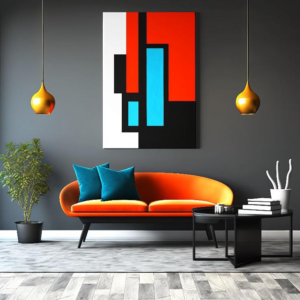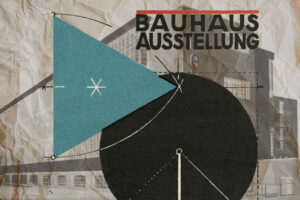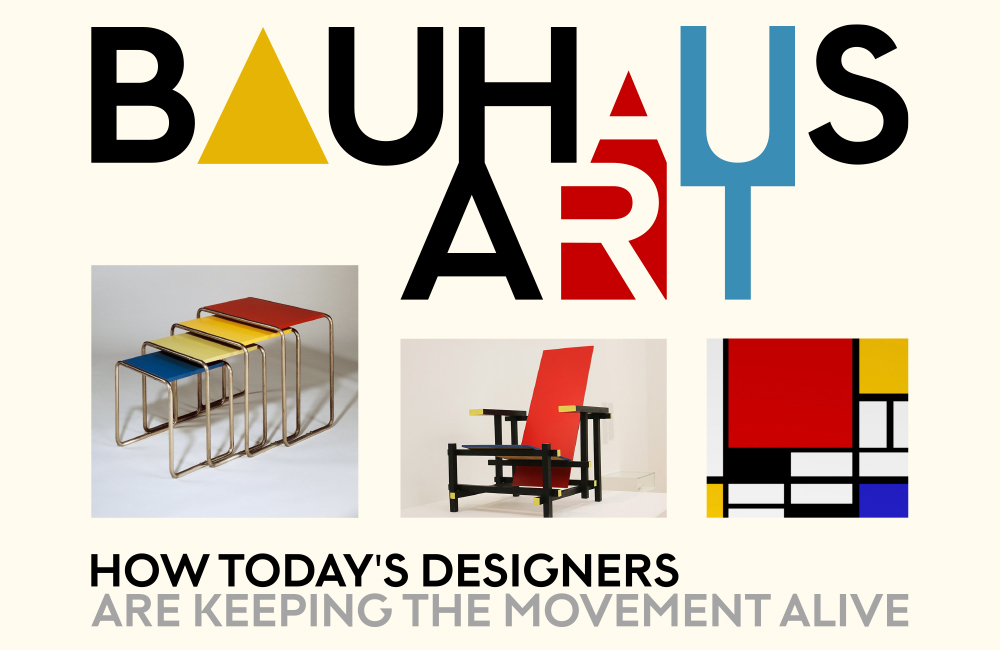Investigating the Stylish of Bauhaus in Advanced Plan
The Bauhaus development, established in 1919 by modeler Walter Gropius in Germany, changed craftsmanship, plan, and engineering, presenting better approaches for pondering structure, capability, and style. Known for its perfect lines, mathematical shapes, and accentuation on moderation and usefulness, Bauhaus keeps on impacting present day plan, including advanced plan. As the computerized age has changed the manner in which we make and connect with plan, the standards of Bauhaus have found areas of strength for an enduring presence in advanced workmanship, website architecture, UIs (UI), and even movement illustrations. This article investigates how the stylish of Bauhaus is implanted in the realm of advanced plan today.

1. Bauhaus Standards: An Establishment for Computerized Plan
At its center, the Bauhaus development was driven by a few key rules that keep on reverberating in computerized plan:
Structure Follows Capability: Bauhaus creators accepted that the type of an item ought still up in the air by its capability. In advanced plan, this means that plan ought to focus on ease of use and usefulness. Sites, applications, and connection points are organized to give clear and effective client encounters (UX), where each plan component fills a viable need.
Straightforwardness and Moderation: Bauhaus specialists stripped away superfluous enhancement and zeroed in on the fundamentals — clean lines, essential shapes, and an absence of ornamentation. This moderate methodology is reflected in contemporary advanced plan, where interfaces frequently utilize straightforward variety plans, clean typography, and natural designs, dispensing with abundance to further develop client experience.
Mathematical Shapes and Evenness: The utilization of mathematical shapes like squares, circles, and triangles was a sign of Bauhaus plan. In computerized plan, these components are as often as possible integrated into logos, symbols, and UIs, giving plans an organized, adjusted, and amicable feel.
Framework Based Formats: The matrix framework was vital to Bauhaus engineering and configuration, making coordinated, adjusted organizations. In advanced plan, networks are fundamental for adjusting content on website pages and applications, guaranteeing that data is introduced plainly and reliably. This permits originators to make responsive designs that adjust to various screen sizes, from cell phones to work areas.
2. Bauhaus Impact in Web and UI Plan
Quite possibly of the most noticeable way Bauhaus feel manifest in the advanced world is through web and UI plan. As sites and applications take a stab at lucidity and usability, many embrace Bauhaus-motivated standards to make smoothed out, proficient encounters.
Moderate Formats: Bauhaus’ accentuation on effortlessness and usefulness converts into the smooth, moderate plans normal in current sites. Well known sites today highlight a lot of blank area, natural route, and an emphasis on key substance. Models like Google’s landing page and Apple’s site utilize extremely insignificant plan components to feature content and usefulness, reflecting Bauhaus’ moderate stylish.
Typography: The Bauhaus development is known for its utilization of strong, sans-serif typefaces like Helvetica and Futura. These textual styles are perfect, present day, and exceptionally clear, which has made them staples in both print and advanced plan. In UI and website composition, clear typography is utilized to guarantee clarity and meaningfulness, guaranteeing that the message is imparted productively and stylishly.
Framework Based Plan: Bauhaus’ accentuation on lattices straightforwardly impacted current website composition rehearses. The network framework considers a coordinated design that is not difficult to explore, making clear visual order. Many website composition structures, for example, Bootstrap or Establishment, utilize a network based framework to make responsive designs that change in view of the screen size, mirroring the Bauhaus ideal of utilitarian, effective plan.
Variety Hypothesis: Bauhaus creators were additionally spearheads in the utilization of variety hypothesis, frequently utilizing essential tones (red, blue, yellow) in their work. In advanced plan, essential tones are many times utilized in brand logos, symbols, and UI components to make strong, outwardly engaging plans. The utilization of brilliant, differentiating varieties can make specific components stick out, for example, motivate buttons on sites or applications.

3. Bauhaus in Computerized Craftsmanship and Movement Illustrations
The standards of Bauhaus have likewise essentially impacted computerized workmanship and movement illustrations. The development’s attention on mathematical deliberation, energetic variety plans, and the convergence of workmanship and innovation has reverberated with contemporary computerized craftsmen.
Mathematical and Dynamic Plans: Bauhaus specialists, for example, Kandinsky and Moholy-Nagy zeroed in on deliberation and the utilization of mathematical shapes. This approach has been embraced in advanced craftsmanship, where visual components are much of the time separated into worked on structures and examples. Craftsmen utilize intense varieties and mathematical plans to make outwardly animating fine art that is both present day and ageless.
Dynamic Visuals in Liveliness: Bauhaus’ impact on movement and movement designs should be visible in the spotless lines, cadenced sytheses, and accentuation on calculation that characterize the stylish. Movement configuration frequently integrates conceptual mathematical shapes, smooth changes, and moderate activity methods — signs of the Bauhaus style. Famous computerized movement configuration projects like introduction successions for films, special recordings, and web activitys mirror this perfect, proficient visual language.
Intuitive Advanced Craftsmanship: The Bauhaus ideal of consolidating workmanship and innovation is reflected in intuitive computerized workmanship, where clients connect straightforwardly with the workmanship through interfaces and advanced apparatuses. For instance, Bauhaus-roused intelligent establishments or generative workmanship pieces utilize mathematical shapes and essential tones that develop and change in view of client input, consolidating plan with innovation continuously.
4. The Job of Innovation in Applying Bauhaus Style
The Bauhaus development was brought into the world in a period of mechanical progression, and its specialists looked to consolidate craftsmanship with modern creation. Likewise, present day computerized plan tackles innovation as an instrument to acknowledge creative dreams and push the limits of structure and capability.
Programming Instruments and Advanced Stages: The improvement of programming apparatuses like Adobe Photoshop, Artist, and Sketch has enabled computerized architects to investigate and make Bauhaus-propelled feel effortlessly. These stages furnish the adaptability to work with lattices, mathematical shapes, and exact variety ranges, while likewise working with effective work processes that accentuate usefulness.
Responsive Plan and Client Experience: Bauhaus’ attention on usefulness and the client experience is reflected in the present advanced plan world through responsive website architecture. Sites are intended to be easy to understand, zeroing in on giving clear, compelling route and quick stacking times. The Bauhaus stylish guarantees that the plan doesn’t eclipse the substance or convenience of the webpage, permitting the client to easily associate with the site.
Movement and Association: Innovation has additionally empowered planners to coordinate development and collaboration into their plans. This is particularly significant in advanced spaces like sites and applications, where activitys or changes can direct clients through the experience. Bauhaus-propelled movement designs use standards like musicality and adjust to make smooth, normal changes that are both outwardly engaging and natural to utilize.

5. Present day Instances of Bauhaus in Advanced Plan
Numerous contemporary organizations and plan studios embrace Bauhaus standards in their computerized plans, frequently as a feature of a general brand procedure. Models include:
Apple: Apple’s site and item interfaces (like iOS and macOS) reflect Bauhaus standards through clean formats, moderate plan, and practical route. The utilization of mathematical shapes, framework based formats, and clear typography repeats the Bauhaus stylish, making an easy to use yet modern experience.
Google: The effortlessness of Google’s landing page and its emphasis on usefulness is an ideal illustration of the Bauhaus guideline “structure follows capability.” Google’s perfect connection point, proficient utilization of blank area, and the consolidation of essential tones in their logo and marking mirrors the Bauhaus style.
Present day Application Plan: Applications like Spotify and Slack grandstand Bauhaus-roused standards in their connection point configuration, utilizing strong typography, straightforward variety plans, and framework based formats to make natural client encounters.
End: Bauhaus and Computerized Plan – An Immortal Relationship
The Bauhaus tasteful has persevered for more than a long time, and its standards keep on impacting computerized plan today. From moderate UIs to the utilization of mathematical shapes, frameworks, and essential tones, the Bauhaus development established the groundwork for the advanced plan world we know today. The development’s attention on usefulness, straightforwardness, and the marriage of workmanship and innovation is as yet important as advanced fashioners keep on investigating additional opportunities in structure and capability. Whether in website composition, computerized workmanship, or movement designs, Bauhaus standards give an immortal structure that assists with making productive, lovely, and easy to understand computerized encounters.


